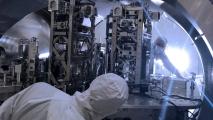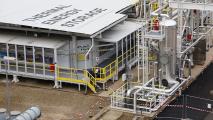Wireless power would be worth the hype if it were widespread — modern life is burdened by a tangle of power cables and an endless hunt for plugs. But despite its potential, wireless power technology is still limited by range.
But Ericsson and PowerLight Technologies have made one dramatic form of wireless power, called optical beaming, work in a proof-of-concept experiment. Their demonstration showed that laser delivery of power to a portable 5G base station could be just around the corner.
The promise of wireless power: Wireless power is straight out of a sci-fi film: electrical power transmitted from place to place through a vacuum or the air. There is no need for wires, poles, outlets, or those pesky USB cubes, which are always lost when you need them most.
The transmitter and the receiver could potentially be hundreds or thousands of meters apart.
It sounds futuristic, but wireless power exists already. You’ve probably come across a few examples without even knowing it — like those pads that you can set your phone on to recharge. (Personally, I think a good ol’ USB-C/lightning cable is less obtrusive — and it has the bonus of never being mistaken for a coaster.)
But wireless power isn’t yet capable of sending a lot of energy, any great distance. That is the crux.
What they did: PowerLight technologies and telecom company Ericsson teamed up to demonstrate how they can beam electricity long-distance, outdoors. They created a system where the transmitter and the receiver could potentially be hundreds or thousands of meters apart.
The system doesn’t blast electricity through the air, like lightning. Instead, the transmitter transforms the energy into photons — a beam of light. The receiver, a 5G base station, has a photovoltaic array (basically, a solar panel) that catches the photons and turns them back into electricity.
To cover any mishaps, they’ve installed a battery backup at the receiver end, just in case, there is a disruption. And, as a safety measure, the photon beam is encircled by a broader “cylinder” of sensors that detect when something comes close and turns off the laser in milliseconds, reports New Atlas.
The team successfully demonstrated their safety ring and showed that hundreds of watts could be transmitted via the air over hundreds of meters using this method.
What this means: In terms of telecommunications, the technology might make it easier to rapidly boost cellular service without building huge permanent towers or hardwiring into the grid, potentially helping emergency services in a crisis or providing temporary coverage increases for sports events and festivals, reports techradar.
“The ability to safely transfer power across distances without having to be connected to the power grid eliminates one of the big obstacles we have when building new cell sites,” said Kevin Zvokel, Head of Networks for Ericsson North America, in a statement.
We’d love to hear from you! If you have a comment about this article or if you have a tip for a future Freethink story, please email us at tips@freethink.com.






